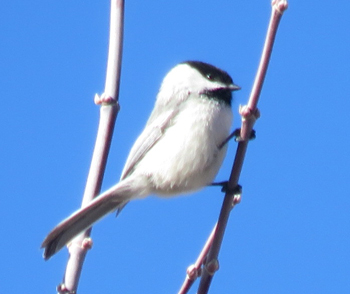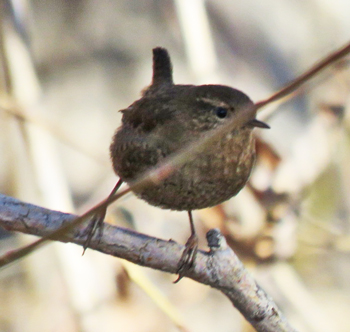Utah County Birders Newsletter
|
||||||||||||||||||||||||||||||||||||||||||||||||||
 |
Contents
April Meeting
Upcoming Field Trips
Captain's Log
Bird of the Month
Field Trip Reports
Thursday, April 12, 2018, 7pm at the Monte L. Bean Museum in Provo, UT.
Winter Birding in Japan: Cranes, Eagles, & Suchi presented by Bryan Shirley.
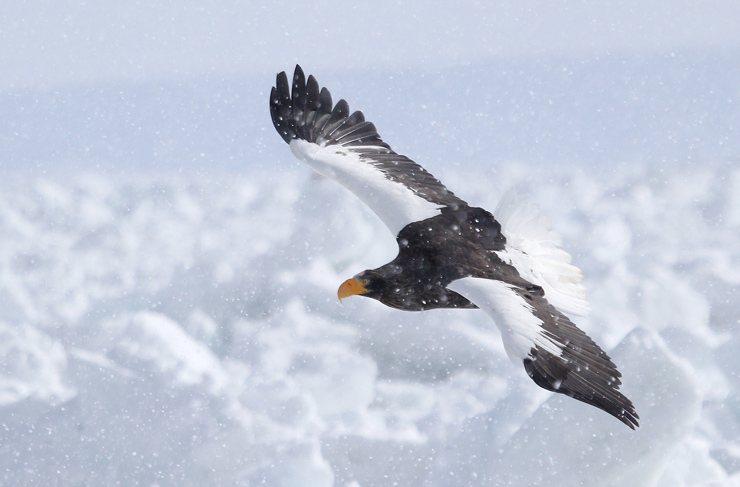 |
|
Steller's Sea Eagle |
RIVER LANE /SANDY BEACH
Saturday April 14, 2018 -- 8am- Noon
We will be meeting at the Springville Walmart and leaving at 8 sharp so please
come early! Park in the NE corner of the parking lot.
From there we will carpool to River Lane. We will park on the dirt road just
past the corrals and walk so it will be easier to see the birds. Moving our cars
occasionally and working our way to Sandy Beach. Let's hope for some good Spring
migrants!
HAWKWATCH- SQUAW PEAK SPRING MIGRATION FIELD TRIP
April 21, 2018 -- 9am-3pm
I will only be able to lead one field trip this month so I have contacted
Hawkwatch and they are willing to let UCB attend their Squaw Peak Hawkwatch
field trip for the member price of $15 instead of $25. This includes a BOX
LUNCH!!!
You need to register through the HWI website so they can get a head count. Here
is the link:
https://hawkwatch.org/participate/calendar/field-trip/455-spring-migration-field-trip
This is a awesome field trip one not to miss :-)
We are actively recruiting people to lead local half-day field
trips, any time, any place. If you would like to lead a field trip or if you
have any ideas for this year’s field trips, please contact Suzi Holt at -
suzerqholt@gmail.com
Utah County Birders
Captain’s Log: April
2018
by Keeli Marvel
Utah County Birders
Captain's Log: April 2018
Spring has sprung! It seems almost magic that one day it's winter and the
weather is cold and miserable and the birds are quiet and reclusive and the next
day the sun is out and the avocets and yellow-headed blackbirds are showing up
in the marshes and the house finches are singing from the tops of the trees. The
return of all the migratory species feels like something worth celebrating for
sure, and for them, surviving another winter and a migration full of hazards is
definitely worth celebrating! Ebird has some pretty cool animations based
directly on birder data that show the timing and movement of different species.
Here's a link for Barn Swallows if you'd like to check that out:
https://ebird.org/science/modeling/barswa. Ebird also has a function to
explore arrival and departure dates by species for whatever location you're
interested in, so if, for example, you want to know when you should be seeing
hummingbirds in your neighborhood, plug in the info for your location, select a
previous year, and check it out! That link is here:
https://ebird.org/sightingsLocation.form?reset=first-false
I don't have much to report yet but I finally got to do a little birding last
week and picked up a few new FOY species. Looking forward to what the next few
weeks bring. Now is the time to be on the lookout for vagrants and rarities
mixed in with the migrants... and the migrants themselves!
A blog I follow recently (shout out to Steve at Bourbon, Bastards, and Birds)
wrote a post recently that I really liked promoting the idea of birding the five
mile radius (5MR) around your home. The concept is similar to birding your local
patch, or to the Christmas bird count circle concept, but instead, includes all
your local patches within a 5MR of your house. I like this idea for several
reasons. When I started exploring the birding options within five miles of my
house I realized there's some under-birded habitat within a walk or a short bike
ride of my house that I haven't given much thought to. Also, some pretty killer
rarities have shown up within 5 miles of my house (remember the scissor-tailed
flycatcher and the little gull?!). I'm also definitely a proponent of being more
conscious of the environmental impact of our birding habits and keeping it close
to home feels pretty satisfyingly eco-friendly. For many birders, family
commitments or obligations, health issues, financial limitations, or mobility
limitations may limit your birding time, and focusing on birding the heck out of
the 5MR around your home could be an easier way to satisfy the birding itch. I
know some of you are probably thinking some people definitely have better 5MR
birding options than others, but I think if you start looking closer you'll find
some hidden gems.
So what are we waiting for!? Let's get out there and see some migrants and enjoy
this beautiful spring weather! I don't know about you, but as soon as I'm done
writing this I'm headed to Powell Lake to see what there is to see. Viva los
migrants!
Happy Birding!
Keeli
by Jeremy Telford
|
As some
of you know, though most do not, I served a religious mission in Hungary.
I was not a birder at the time but nature always fascinated me. Once a
week we had a day off and were encouraged to explore what Hungary had to
offer. If my companion was willing I would often opt for exploring
Hungary’s few forests. While there I saw wild boars, deer, song birds, but
no hedgehogs, which always bummed me. I was able to see the storks nesting
on the chimney tops of houses. Many houses put up a false chimney on their
roof away from the real one so they could have a nesting stork without the
nest filled chimney. Storks were considered good luck and no one wanted to
shoo them away. |
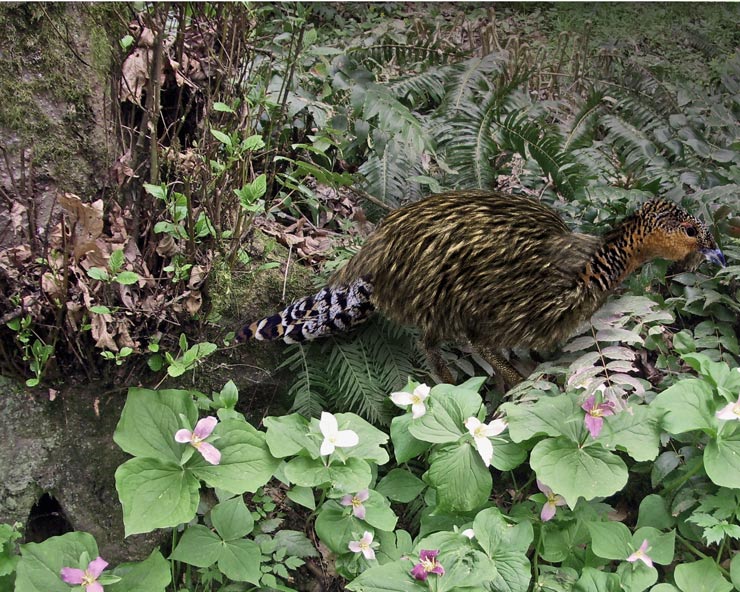 |
|
After our Golden Corral dinner, and
reminiscing with Milton Moody, I decided to look back through my Hungarian
photos to see if I could pick up any new lifers. I had forgotten about
this bird. In fact I had to message a few of my Hungarian friends to find
out what it was. In Hungarian it is called a Prémesfajd which loosely
translated means Furred or Furry Grouse. The scientific name is
Aprilis stultorumus. After a lot of digging and a lot of Google translate
(my Hungarian is rusty) this is what I was able to find out. The
Prémesfajd is one of the smallest flightless birds in the world, only the
Kiwi and a few species of penguin are smaller. It is native to the forests
of Hungary, especially the area around lake Tisza and the Hortobágy
National Park in Eastern Hungary. The populations are not large and are
considered threatened. Legislation passed through the parliament in 1982
has helped to protect this species and it is making a slow comeback. It
has made enough of a comeback that they have started to reintroduce it to
other parts of Hungary and southern Slovakia as of the early 2000s.The
“Furred Grouse” eats leaves, twigs, buds, berries, fruit, and insects. Its
main predators are raptors, and domestic dogs and cats. Wolves used to
prey on these birds when they roamed Hungary’s forests. Though the grouse
cannot fly it is an excellent climber. Strong feet and large claws allow
this bird to gain purchase on the rough bark of the indigenous trees. The
Prémesfajd is a small grouse though I couldn’t find an exact size for it
on line.It is believed both the grouse and forests used to be plentiful in
Hungary until it was settled by the descendents of the Ugric-Finnic tribe
which came down out of Russia. Once settled the people spread requiring
food and supplies. The forests were rapidly depleted. Deer, boar, and
other animals including the Prémesfajd were hunted relentlessly. Sometime
in the 10th century King István V set aside the land around Lake Tisza as
a hunting preserve and mot likely unwittingly saved the species. Only the
king and those given permission were allowed to hunt on the land and
caretakers were assigned to ensure there was always a ready population of
prey for the hunters. In 1526 the Turks invaded Hungary. Despite a strong
and desperate defense Hungary waseventually overwhelmed. The Ottoman
Empire ruled Hungary for the next 145 years. All royal lands became the
property of the Sultan. The hunting preserve was likely undisturbed during
this time further helping the cause of the grouse. In any case the “Furred
Grouse” survived in these few forests for hundreds more years until it was
finally officially protected in 1982. I am still amazed that I was able to see this bird and wish I remembered more about the encounter. The one picture I got was dark but I’ll take it! If you ever travel to Hungary and happen to find yourself in the forests of the Hortobágy National Park listen closely for the sound of the Prémesfajd. Besides the usual grouse clucking it can make a surprisingly loud and jovial call. It sounds something like a chuckled, “Ayepril-Phools!” |
Click here for past 'Birds of the Month'.
|
Field Trip Reports |
|
|
South Fork / Sundance - 10 Mar 2018 by Suzi Holt |
|
| Twenty-seven
birders showed up this beautiful morning. We started out at Canyon Glen Park
and checked off the American Dipper, seeing two Dippers and two Song
Sparrows. |
|
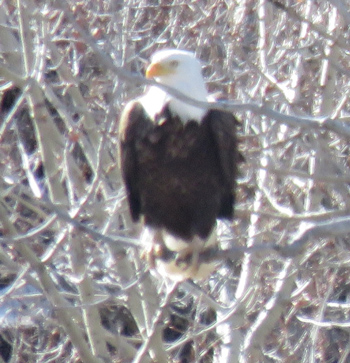 |
From there we went on our quest for the Northern Pygmy Owl. Our first stop was Southfork Park, they were filming a movie with knights on horses. Strike 1. Next stop Big Springs Park where they were racing a remote control car. Strike 2. Consolation prize....Bald Eagle, Wild Turkeys, Black-capped Chickadees, Townsend's Solitaire, Ravens, a couple mallards and a Scrub Jay. |
| Bald Eagle |
|
|
|
|
|
Black-capped Chickadee |
Pacific Wren |
|
From there we headed for the parking lot above
Aspen Grove, the fee station is open although the loop isn't but to go to
the parking lot you have to pay. Strike 3! Does anyone want to aee a Pacific
Wren??? YES!!! Off to the oxbow we went. A cooperative Pacific Wren,
such a cute little bird, we all got great looks. We also saw lots of Coots,
heard a Downy Woodpecker and found the Wood duck with a crush on a
Mallard hen. We got a text from Jeff Hardy saying he had seen a Northern
Mockingbird at the Provo Airport Dike. We got skunked on the Mockingbird but
saw a Red-tailed Hawk, American Kestrals, Gadwall, lots of Flickers Juncos,
White-crowned Sparrows and the American Tree Sparrows!!! It was a
beautiful day and great company. |
|
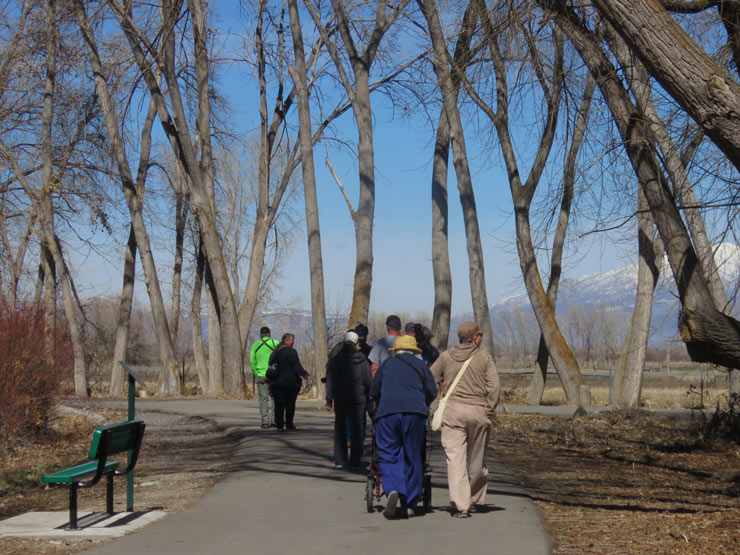 |
|
|
Birders at "The Oxbow" |
|
|
Emma Park Road / Scofield / Dairy Fork - 24 Mar 2018 by Suzi Holt |
|
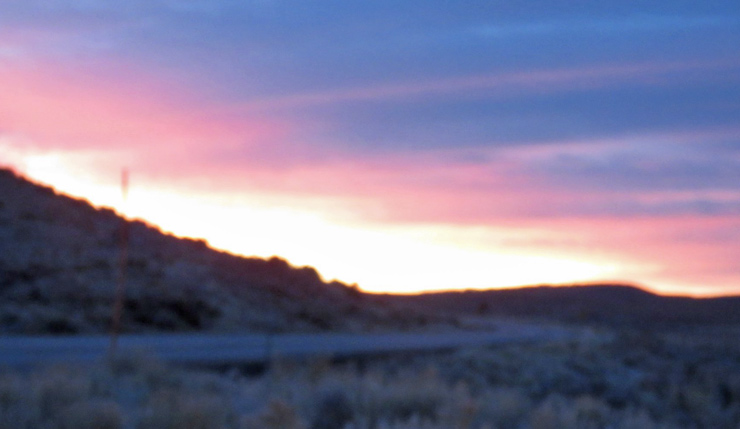 |
|
|
Twenty birders set out for the Emma Park Sage Grouse Lek at 6:00 am. Yikes I am not a early riser and 5:00 am came way too early. We got to the Lek about 6:50. We were almost to the corral parking lot when I spotted 5 Greater Sage Grouse close to the road in a open field. There were 4 males and a female. The males were displaying and what a sight that is!. It was too early for decent photos, but we got a good show for about 7 minutes before they were spooked back into the sage. Wow, that was fast! |
|
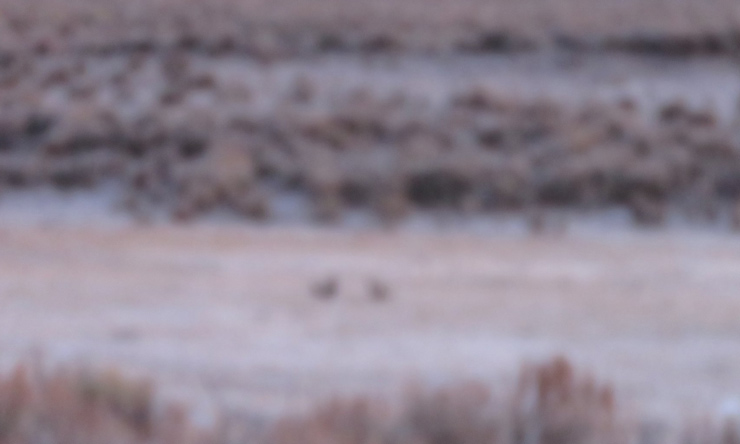 |
|
|
Greater Sage Grouse Lek - picture taken while still
dark |
|
|
So off we went to Scofield. On the way we saw
Stellar's Jays,
Scrub Jays, Robins and Red-tailed Hawks. We also got great looks at a
herd of Elk.
We stopped at the North end of the lake by a little open water and a pond.
We saw Canada Geese, Green-winged Teal, Cinnamon Teal, Mallards, Red-winged
Blackbirds and Song Sparrows. On the south end of the lake we saw more
Canada Geese, Ravens and some
Sand Hill Cranes.
In town we saw more Red-winged Blackbirds, Brewer's Blackbirds,
Townsend's Solitaire,
and Black-billed Magpies. We continued up past the mine to look for a
Three-toed Woodpecker and Gray Jays. No luck on them but at the top we had a
surprise Male
Pine Grosbeak
and a cute
Mountain Chickadee.
On the way down a Coyote ran across the road and up the hill. |
|
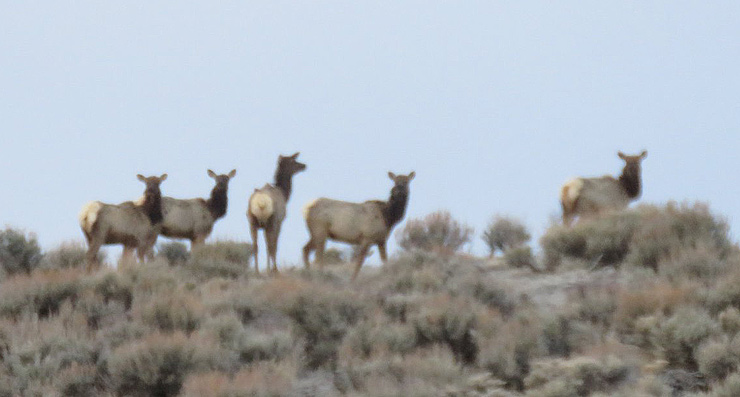 |
|
|
On the way to Scofield |
|
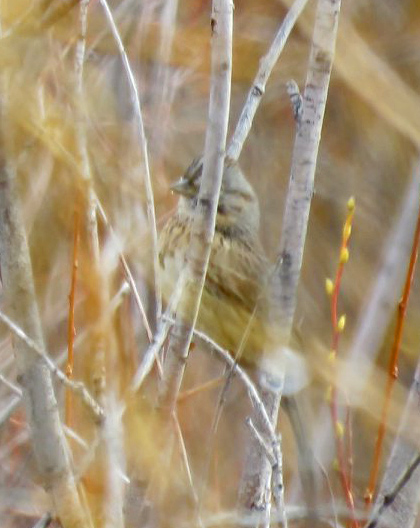 |
We decided to head back down and stop at Dairy Fork and try our luck for a Pygmy Owl. No luck on the Pygmy Owl but we were excited to see Mountain Bluebirds, more Black-billed Magpies, Ravens, Stellar Jays and a Scrub Jay, a Flicker, Red-winged Blackbirds, Song Sparrows and a Lincoln's Sparrow. The cars and our shoes got a little muddy and we enjoyed listening to Nicole Telford practicing her bird calls! Thanks to all for joining us! |
|
Lincoln's Sparrow |
|
Printable Version of this UCB Newsletter
